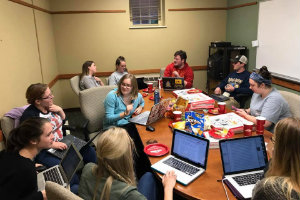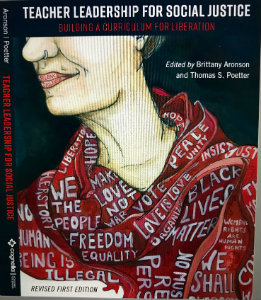Oppression Still Persists in Schools. But Social Justice Teaching Can Help Break the Cycle


James M. Loy, Miami University
It’s a basic cultural assumption in our society, that schools are intended to help students thrive, and that they function with students’ best interests at heart. But this assumption, especially in light of the challenges that so many schools face today, might not always hold true.
We continue to hear about schools struggling to meet an array of policy-based standards. About others that are failing to stay relevant alongside a quickly evolving 21st century society. And how many, particularly those in urban areas, are unprepared to address the needs of increasingly diverse student populations.
Many schools seem to be failing in these areas. And according to some experts, the reasons can be traced back to systemic forms of oppression that continue to dominate the educational landscape.
“The way that school is set up period is oppressive,” says Brittany Aronson, Miami University assistant professor of educational leadership. “A lot of the research around urban schools is that schools are actually doing exactly as they are intended to -- sort and train and assimilate. So when people say schools are ‘failing,’ and that that’s the problem, they are doing exactly what they were intended to do.’
“I say this,” she explains, “because we have the research to support effective teaching, yet as a society, we continue to promote standards-based accountability over culturally relevant ways of teaching and learning.”
The cycle of oppression
Aronson often works with future teachers to unpack the structural problems that continue to perpetuate both inequality and oppression in schools today, and she emphasizes social justice teaching as a way for both potential and practicing educators to push back against these social forces.
By saying that schools are oppressive and set up to fail, Aronson is referring to the cultural and structural obstacles that can inhibit effective teaching, stifle student success, and sustain inequalities on numerous fronts.
In urban schools, for example, there is a growing cultural mismatch. According to a 2016 Department of Education racial diversity report, 82% of teachers in public schools still identify as white, while students of color are soon expected to comprise 54% of all students.
 This growing disparity does not mean that white educators will automatically fail. But they are in a position where more culturally relevant teaching methods are becoming necessary, and most teachers simply don’t yet possess the knowledge base needed to engage these students in authentic or meaningful ways.
This growing disparity does not mean that white educators will automatically fail. But they are in a position where more culturally relevant teaching methods are becoming necessary, and most teachers simply don’t yet possess the knowledge base needed to engage these students in authentic or meaningful ways.
“Many white teachers are very unprepared to be in the spaces they are working in,” Aronson says. “So sending unprepared teachers into these spaces is a way of continuing to oppress students. And then, because they are unprepared, it is also really hard to create connections with students. It is really hard to develop relationships, which would be the number one thing to help maintain a productive learning environment.”
What’s more, this inability to build meaningful relationships is further impeded by sheer class size, which is another problem in many urban schools. And this is a disconnect that damages more than just productivity.
“This disconnect leads to over disciplining,” says Aronson. “And we know, again, that students of color are suspended at higher rates than their white peers for doing similar types of things. Tons of research has looked at the way that discipline happens with similar infractions. It’s called the ‘discipline gap,’ and a teacher’s unconscious bias can lead to it.”
So, basically, growing cultural differences tend to preclude teachers from developing meaningful relationships with their students, who often occupy overcrowded classrooms, which can then lead to a negative learning environment filled with more and more disciplining, especially for a disproportionate number of students of color, all of whom now make up approximately half of all students.
Faced with this spiraling situation, it is not hard to see how academic performance will also start to suffer as well, which can make even the curriculum itself another problematic area. And not just in urban schools, but in all underperforming schools struggling against a rigid set of imposed policy-based standards. Because the worse a school does academically, the more enforced and scripted the curriculum usually becomes.
But “not everything can be so one-size-fits-all,” Aronson explains. “You don’t know where your students will be in their thinking, or about how you will have to address or accommodate them. So that is another example of an oppressive structure that continues to perpetuates or maintain inequality.”
Stopping the cycle
Teachers are often associated with people who hope to make a positive difference in the lives of others. It’s the reason many were drawn to the profession, and it’s a message that’s generally encouraged by society.
But how is this actually accomplished? Especially in an oppressive educational climate that seems to suppress equality and performance at multiple turns?
“If we continue doing school the same way -- and we have been doing school the same way -- we are not going to create change,” says Aronson. “We can talk all day long about teachers as ‘change agents.’ But if they don’t have a contextual understanding it is hard to be a change agent.”
And this, according to Aronson, is exactly what makes social justice teaching such a critical focus.
But it requires introducing a new generation of teachers to the contextual and sociocultural issues that impact schools on many levels, which means teachers need to have more than just content knowledge or a grasp of basic teaching methods to be effective.
It means teachers also need to know about the sociocultural history of schools and they need to acquire a firm understanding of the root causes of systemic inequality, which can inspire educators to make the extra effort in learning more about their students.
It means connecting with culturally relevant content that helps marginalized students of color see themselves within the curriculum. 
It means getting creative with the subject material by teaching in ways that both satisfy policy-based standardizations and in ways that stay relatable and interesting to contemporary students.
And it means learning how to start productive dialogues around uncomfortable issues and learning how to value difference. For white teachers, this even means “owning whiteness” and understanding how it might impact one’s teaching, which is a lesson Aronson says she herself had to learn.
And, of course, it all applies to educational environments that stretch beyond the context of just urban-based public schools alone.
“Sometimes students don’t think they will have to tackle these issues if they end up teaching in a predominantly white school, or a school that’s highly affluent with students who come from privileged backgrounds,” says Aronson. “But these are the spaces where we need to see them more. If we are going to disrupt the cycle, it does not matter what type of school context you are going into. You have to be prepared to deal with teaching different issues.”
At Miami University, this process starts by teaching future educators how to value difference and diversity. They also learn to become aware of their own hidden biases and about how such preconceptions can unintentionally perpetuate oppression.
In her own courses, Aronson starts this conversation on day one by introducing all students to an article called “Willing to be Disturbed,” which sets the stage for an ongoing dialogue that covers many difficult subjects like race and class and inequality and more.
And sometimes the students don’t like what they hear. And sometimes they struggle with the enormity of the issues.
But nobody said it would be easy.
“Students have told me, ‘But I don’t know about these things. I don’t know about this sociocultural history.’” Aronson says. “Well, you are going to have to learn it. You’re going to learn and unlearn and relearn. If you are going to do this work, then do the work.”
“And it starts,” she says, “with that self-work.”

